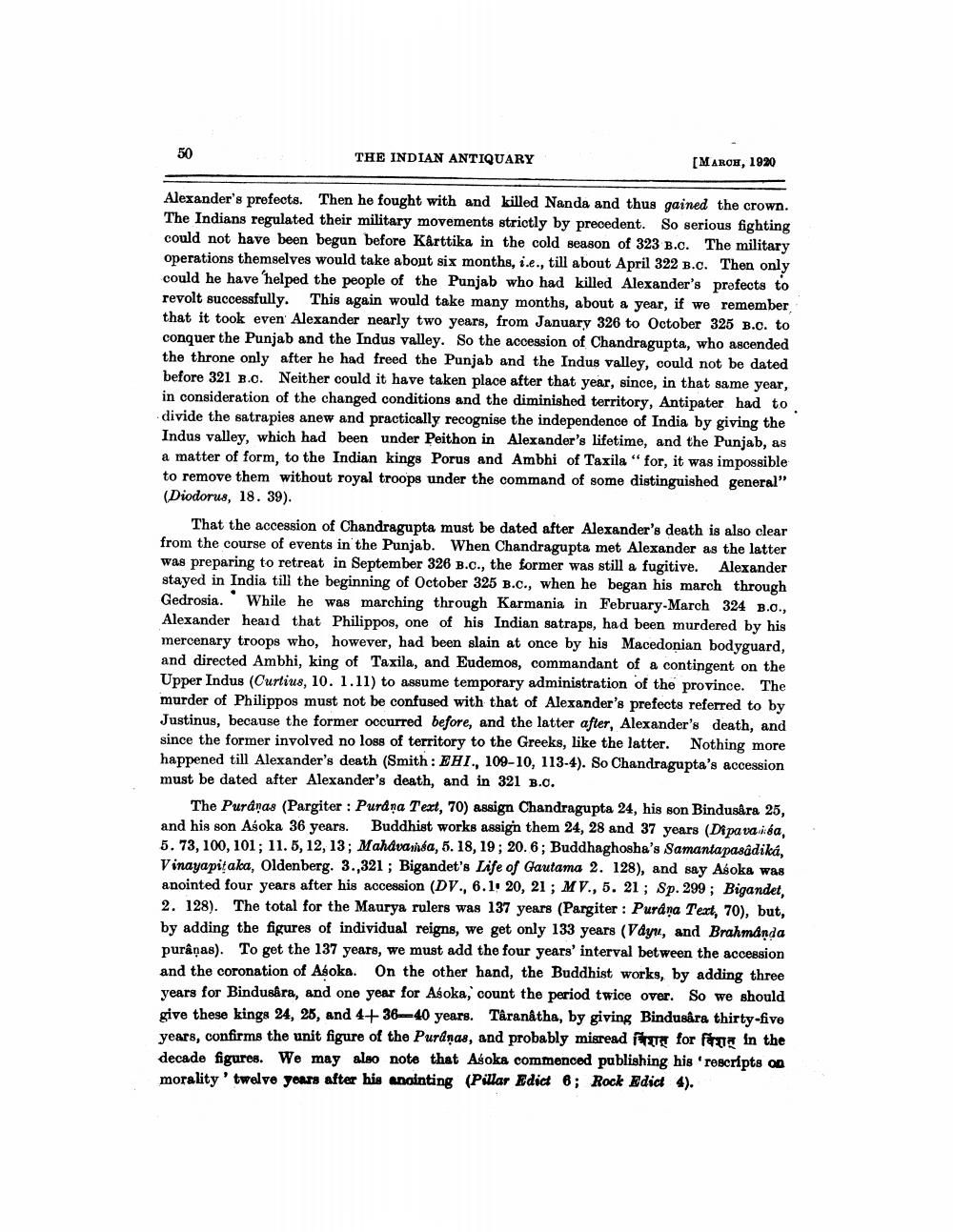________________
THE INDIAN ANTIQUARY
[MARCH, 1920
Alexander's prefects. Then he fought with and killed Nanda and thus gained the crown. The Indians regulated their military movements strictly by precedent. So serious fighting could not have been begun before Karttika in the cold season of 323 B.C. The military operations themselves would take about six months, i.e., till about April 322 B.C. Then only could he have helped the people of the Punjab who had killed Alexander's prefects to revolt successfully. This again would take many months, about a year, if we remember that it took even Alexander nearly two years, from January 326 to October 325 B.c. to conquer the Punjab and the Indus valley. So the acoession of Chandragupta, who ascended the throne only after he had freed the Punjab and the Indus valley, could not be dated before 321 B.C. Neither could it have taken place after that year, since, in that same year, in consideration of the changed conditions and the diminished territory, Antipater had to divide the satrapies anew and practically recognise the independence of India by giving the Indus valley, which had been under Peithon in Alexander's lifetime, and the Punjab, as a matter of form, to the Indian kings Porus and Ambhi of Taxila " for, it was impossible to remove them without royal troops under the command of some distinguished general" (Diodorus, 18. 39).
That the accession of Chandragupta must be dated after Alexander's death is also clear from the course of events in the Punjab. When Chandragupta met Alexander as the latter was preparing to retreat in September 326 B.C., the former was still a fugitive. Alexander stayed in India till the beginning of October 325 B.C., when he began his march through Gedrosia.' While he was marching through Karmania in February March 324 B.O., Alexander heard that Philippos, one of his Indian satraps, had been murdered by his mercenary troops who, however, had been slain at once by his Macedonian bodyguard, and directed Ambhi, king of Taxila, and Eudemos, commandant of a contingent on the Upper Indus (Curtius, 10. 1.11) to assume temporary administration of the province. The murder of Philippos must not be confused with that of Alexander's prefects referred to by Justinus, because the former occurred before, and the latter after, Alexander's death, and since the former involved no loss of territory to the Greeks, like the latter. Nothing more happened till Alexander's death (Smith: EHI., 109-10, 113-4). So Chandragupta's accession must be dated after Alexander's death, and in 321 B.O.
The Purdņas (Pargiter : Purana T'ext, 70) assign Chandragupta 24, his son Bindusåra 25, and his son Asoka 36 years. Buddhist works assign them 24, 28 and 37 years (Dipava isa, 5. 73, 100, 101; 11. 5, 12, 13; Mahdvansa, 5. 18, 19; 20.6; Buddhaghosha's Samanta pasadiká, Vinayapitaka, Oldenberg. 3.,321 ; Bigandet's Life of Gautama 2. 128), and say Asoka was anointed four years after his accession (DV., 6.1. 20, 21 ; MV., 5. 21; Sp. 299; Bigandet, 2. 128). The total for the Maurya rulers was 137 years (Pargiter : Purana Text, 70), but, by adding the figures of individual reigns, we get only 133 years (Vdyn, and Brahmånda purânas). To get the 137 years, we must add the four years' interval between the accession and the coronation of Asoka. On the other hand, the Buddhist works, by adding three years for Bindusara, and one year for Asoka, count the period twice over. So we should give these kings 24, 25, and 4+ 36-40 years. Târanátha, by giving Bindusara thirty-five years, confirms the unit figure of the Purdņas, and probably misread fry for fun in the decade figures. We may also note that Asoka commenced publishing his rescripts on morality 'twelve years after his anointing (Pillar Edict 8; Rock Edict 4).




